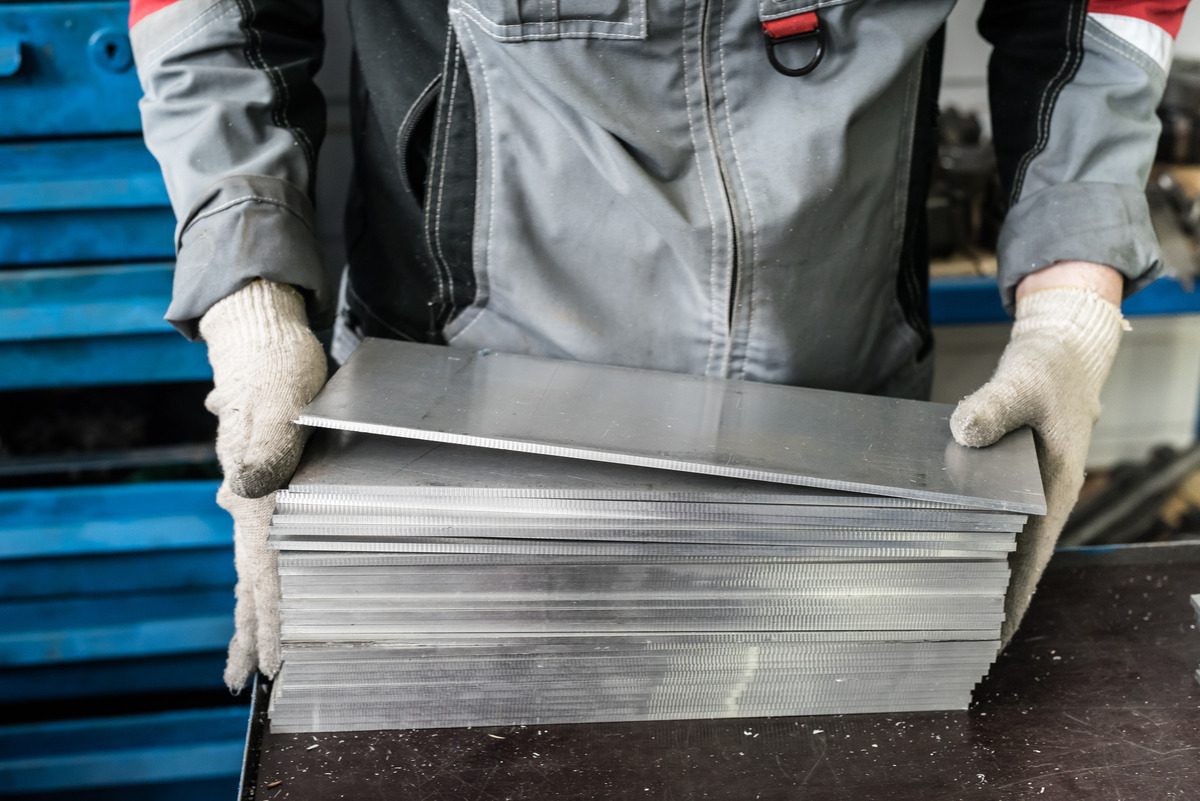Sheet metal thickness is an important factor in fabrication. Metal fabrication shops often work with raw stock sheet metal from 0.02” to 0.250” thick. What does that mean for you, the customer?
Sheet thickness affects the tools and time needed to manipulate the metal and fabricate your design. Since sheet metal thickness can change how we work with the material, it influences the cost of your project.
Sheet metal gauges specify thickness. Find out more about gauges. Use this resource to explore sheet metal gauges for steel and aluminum.
Jump to:
- What Are Sheet Metal Gauges?
- Carbon Steel Gauge Thickness Chart
- Stainless Steel Gauge Thickness Chart
- Galvanized Steel Gauge Chart
- Aluminum Sheet Gauge Chart

What Do Sheet Metal Gauges Mean?
Sheet metal gauges are a form of measurement. They are not to be confused with sheet metal grades. Grades refer to a metal’s composition. Gauges refer to a sheet’s thickness.
While we can measure sheet metal in inches, millimeters and mils, we can also find a metal’s thickness in relation to its weight per square foot. Metal gauges are identifiers for the relationship between thickness and weight.
In other contexts, larger numbers mean that there’s more of something. As numbers increase, the subject gets larger, longer or heavier. Imagine you are measuring office tables. You know a 6′ table is longer than a 3′ table. The larger measurement indicates a larger object.
The opposite occurs with gauges. Gauge numbers get larger as the sheet metal thins. Higher sheet metal gauges indicate that you’re working with a thinner sheet. Lower gauge numbers identify thicker sheets of metal. As gauges increase, metal sheets get thinner.
Not all types of metals use the same gauge system. Aluminum and other nonferrous metals use the Brown and Sharpe system (also known as the American Wire Gauge). Carbon steel, galvanized steel and stainless steel use the Manufacturer’s Standard Gauge scale.
Below are sheet metal gauge charts for common metals. You’ll find the gauge and its corresponding thickness in inches and millimeters.
Carbon Steel Gauge Thickness Chart
| Carbon Steel Sheets
|
||
| Gauge | Inches | MM |
| 3 | 0.2391 | 6.07 |
| 4 | 0.2242 | 5.69 |
| 5 | 0.2092 | 5.31 |
| 6 | 0.1943 | (4.94) |
| 7 | 0.1793 | 4.55 |
| 8 | 0.1644 | 4.18 |
| 9 | 0.1495 | 3.80 |
| 10 | 0.1345 | 3.42 |
| 11 | 0.1196 | 3.04 |
| 12 | 0.1046 | 2.66 |
| 13 | 0.0897 | 2.28 |
| 14 | 0.0747 | 1.90 |
| 15 | 0.0673 | 1.71 |
| 16 | 0.0598 | 1.52 |
| 17 | 0.0538 | 1.37 |
| 18 | 0.0478 | 1.21 |
| 19 | 0.0418 | 1.06 |
| 20 | 0.0359 | 0.91 |
| 21 | 0.0329 | 0.84 |
| 22 | 0.0299 | 0.76 |
| 23 | 0.0269 | 0.68 |
| 24 | 0.0239 | 0.61 |
| 25 | 0.0209 | 0.53 |
| 26 | 0.0179 | 0.45 |
| 27 | 0.0164 | 0.42 |
| 28 | 0.0149 | 0.38 |
| 29 | 0.0135 | 0.34 |
| 30 | 0.0120 | 0.30 |
These steel gauge charts aren’t exhaustive lists. A 38-gauge steel sheet, for example, is 0.0060” thick.
Stainless Steel Gauges
| Stainless Steel Sheets
|
||
| Gauge | Inches | MM |
| 7 | 0.1875 | 4.76 |
| 8 | 0.1719 | 4.37 |
| 9 | 0.1563 | 3.97 |
| 10 | 0.1406 | 3.57 |
| 11 | 0.1250 | 3.18 |
| 12 | 0.1094 | 2.78 |
| 13 | 0.094 | 2.4 |
| 14 | 0.0781 | 1.98 |
| 15 | 0.07 | 1.8 |
| 16 | 0.0625 | 1.59 |
| 17 | 0.056 | 1.4 |
| 18 | 0.0500 | 1.27 |
| 19 | 0.044 | 1.1 |
| 20 | 0.0375 | 0.95 |
| 21 | 0.034 | 0.86 |
| 22 | 0.0312 | 0.79 |
| 23 | 0.028 | 0.64 |
| 24 | 0.025 | 0.64 |
| 25 | 0.022 | 0.56 |
| 26 | 0.019 | 0.48 |
| 27 | 0.017 | 0.43 |
| 28 | 0.016 | 0.41 |
| 29 | 0.014 | 0.36 |
| 30 | 0.013 | 0.33 |
Galvanized Steel Thicknesses
| Galvanized Steel Sheets
|
||
| Gauge | Inches | MM |
| 8 | 0.1681 | 4.27 |
| 9 | 0.1532 | 3.89 |
| 10 | 0.1382 | 3.51 |
| 11 | 0.1233 | 3.13 |
| 12 | 0.1084 | 2.75 |
| 13 | 0.0934 | 2.37 |
| 14 | 0.0785 | 1.99 |
| 15 | 0.0710 | 1.8 |
| 16 | 0.0635 | 1.61 |
| 17 | 0.0575 | 1.46 |
| 18 | 0.0516 | 1.31 |
| 19 | 0.0456 | 1.16 |
| 20 | 0.0396 | 1.01 |
| 21 | 0.0366 | 0.93 |
| 22 | 0.0336 | 0.85 |
| 23 | 0.0306 | 0.78 |
| 24 | 0.0276 | 0.70 |
| 25 | 0.0247 | 0.63 |
| 26 | 0.0217 | 0.55 |
| 27 | 0.0202 | 0.51 |
| 28 | 0.0187 | 0.47 |
| 29 | 0.0172 | 0.44 |
| 30 | 0.0157 | 0.40 |
Aluminum Sheet Gauge Chart
Aluminum, copper and other nonferrous metals use the Brown and Sharpe system. Below are the thicknesses associated with aluminum sheet metal gauges.
| Aluminum Sheets
|
||
| Gauge | Inches | MM |
| 6 | 0.162 | 4.1 |
| 7 | 0.1443 | 3.67 |
| 8 | 0.1285 | 3.26 |
| 9 | 0.1144 | 2.91 |
| 10 | 0.1019 | 2.59 |
| 11 | 0.0907 | 2.3 |
| 12 | 0.0808 | 2.05 |
| 13 | 0.072 | 1.8 |
| 14 | 0.0641 | 1.63 |
| 15 | 0.057 | 1.4 |
| 16 | 0.0508 | 1.29 |
| 17 | 0.045 | 1.1 |
| 18 | 0.0403 | 1.02 |
| 19 | 0.036 | 0.91 |
| 20 | 0.0320 | 0.81 |
| 21 | 0.028 | 0.71 |
| 22 | 0.025 | 0.64 |
| 23 | 0.023 | 0.58 |
| 24 | 0.02 | 0.51 |
| 25 | 0.018 | 0.46 |
| 26 | 0.017 | 0.43 |
| 27 | 0.014 | 0.36 |
| 28 | 0.0126 | 0.32 |
| 29 | 0.0113 | 0.29 |
| 30 | 0.0100 | 0.25 |
Where Did Sheet Metal Gauges Come From?
Sheet metal gauges originate from wire drawing. Before the industrial revolution, wire was sold by weight. Selling by weight alone was problematic. Wires could be many thicknesses at the same weight, which meant customers ended up with nonuniform wire.
At the time, there was no method for measuring wire diameter, so it was challenging to communicate what wire size was needed. Wire drawers sought a solution by quoting wire based on the number of draws required to create it. The number of draws became the gauge.
As a form of measurement, gauges developed from drawing wires through thinner and thinner dies and assigning each a number. When steelmakers began rolling sheets of steel, they followed suit.
Steelmakers discovered it was difficult to measure sheets by their thickness. Instead, they wanted to measure sheets by weight per square foot. Steel producers began using the gauge system to specify sheet metal thickness.
Why Do Sheet Metal Gauges Matter?
A sheet metal’s gauge can affect the methods used to cut, form and weld it.
Gauges help engineers determine the most effective design and the path forward for manufacturing it. Fabricators, welders and machine operators also benefit from this knowledge since sheet metal gauges help determine the best methods to use.
For example, high heat can harm thin-gauge metals. Burn-through and surface distortion are risks when welding thinner materials, so welders must try to minimize the metal’s heat exposure. With thinner materials, welders may start and stop often to let the weld area cool or spread smaller welds out over the joint.
Thin-gauge sheets can be challenging to weld, whereas thicker materials are more difficult to bend. By maintaining a minimum inside bend radius, you can minimize cracking and hardening at the bend when working with thick sheets or plates. The minimum radius increases as a sheet’s thickness increases.
These are two examples of how sheet metal gauges play into the fabrication process. Do you have questions about sheet metal? Do you need an experienced fabrication company to develop custom metal components?
Metaltech has helped companies produce custom parts for over 20 years. We offer a full range of metal manufacturing capabilities. We’ll answer your questions and guide you through the manufacturing process. Trust our team to do it right—every time.
Click to request a quote today! Let’s work together.




